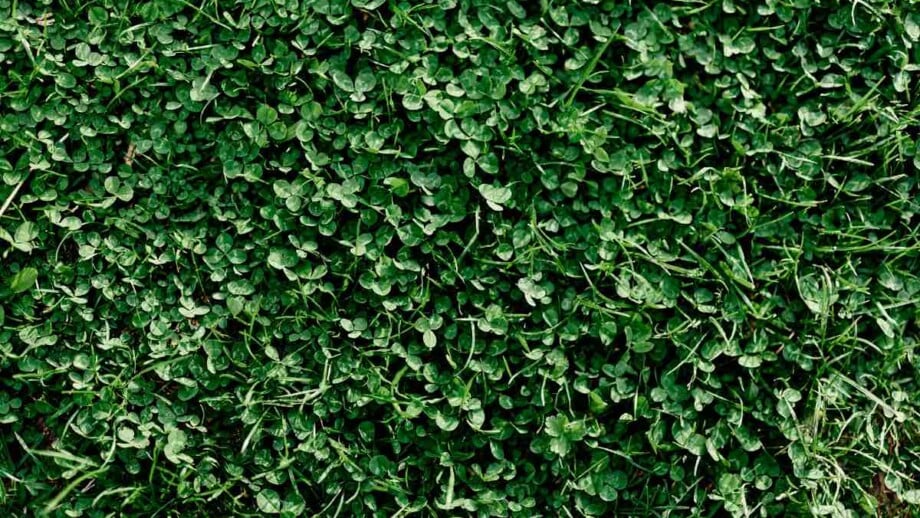If you’re tired of mowing your turf lawn all the time and fretting about watering regularly to keep it green, a clover lawn may be exactly what you need! Clover lawns are becoming increasingly popular among homeowners for their lush, green appearance and low-maintenance requirements.
Clover has been around for centuries and was traditionally used by farmers to feed their livestock until it started being considered a weed. But more and more homeowners are realizing its potential as a hassle-free, eco-friendly solution for landscaping.
Not only do clover lawns attract pollinators such as bees and butterflies, but they’re also drought-tolerant and have nitrogen-fixing abilities! This means you won’t need any fertilizer whatsoever to keep your clover lawn lush and green.
And what’s best is that you only need to mow a clover lawn a few times a year as opposed to a regular turf lawn that needs to be mowed at least once a week.
But are there any drawbacks to having your own clover lawn? And what else do you need to consider? We discuss all that and more in our complete guide to clover lawn. Learn what exactly it is, the common types of clovers, and the 14 things you need to consider before having your own clover lawn.
What is Clover?
Clover is a dense ground cover with shamrock-shaped leaves and blooms that attract pollinators.
Originally from the Mediterranean, it was brought to the New World in the 1600s and quickly became a staple for farmers in America. After that, it was common to see clover in lawns before people started to view it as a weed.
A little-known fact about clover is that it has the ability to ‘fix’ nitrogen for other plants (as well as for itself), and so offers a natural boost of fertilizer. Clover is regarded as a living mulch due to its nitrogen-fixing ability and is a legume, which means it’s related to peas, peanuts, and beans.
There are around 300 species of clover found globally. It is concentrated in the Northeast, Northwest, and Midwest of the United States. Let’s look at the most common types of clovers that you should consider looking into.
Types of Clover
For an even, lush lawn, experts recommend mixing clover with typical grass or with a variety of different clover species, though you can cultivate a single species of clover lawn if you want to.
Let’s look at the three most common types of clover and the turf grass you can pair it with:
White Clover
The most well-known clover in the United States is the white clover (Trifolium repens). It spreads quickly and rapidly, outcompetes weeds, and does well in poor soil. It also produces beautiful white flowers that are adored by pollinators. Varieties of white clover grow to a height of 4 to 8 inches.
You can pair white clover with red clover, Kentucky bluegrass, Bermudagrass, red fescue, or hard fescue.

Red Clover
Red clover (Trifolium pratense) is prized for its attractive reddish-purple blooms, graceful stature, and natural medicinal properties. It can grow to a height of 6 to 24 inches, making it significantly taller than white clover.
You can pair red clover with white clover, sweet clover, perennial ryegrass, Bermudagrass, or tall fescue.

Microclover
Microclover (Trifolium repens var. “Pirouette” and “Pipolina”) is a new variety of white clover that is becoming increasingly popular.
Compared to white clover, it has smaller leaves, and fewer flowers, and also grows lower to a height of about 4-6 inches tall. It is also less prone to clumping than white clover, allowing it to integrate nicely with other grasses.
You can pair microclover with Kentucky bluegrass or tall fescue.

What You Need to Know Before Considering a Clover Lawn
1. Clover Lawns Need to be Mowed Infrequently
Unlike grass lawns, which often need to be mowed once a week, a clover lawn only needs to be mowed a few times a year. This is because a lawn of white clover only grows 2 to 8 inches high. Midseason lawn mowing is a popular way for some homeowners to freshen up their yards and remove spent blooms.
Your lawn can be better prepared for winter if you mow a clover lawn about four to six weeks before the first frost. Even so, you do not have to spend every weekend cutting the clover lawn like you would with turf.
2. Clover Lawns Require Less Watering
In addition to requiring less mowing than most grasses, clover lawns also require less watering. This is mainly because clover grass is drought-tolerant. However, it may remain green throughout the year, even in northern hardiness zones.
Turfgrass, on the other hand, needs at least an inch of water every week. Regular and excessive watering can lead to the runoff of pesticides and other chemicals, which contaminate our waterways and poison wildlife.
Since clover has considerably deeper roots than grass, planting clover instead of grass will require significantly less watering!
3. Clover Lawns Don’t Need Fertilization
Because clover is a legume, it absorbs nitrogen from the air and transmits it to the ground, where the gas enhances the quality of nearby plants and soil. If your yard has poor soil, clover is a great option because it grows well in both compacted and poorly draining conditions.
If your lawn consists of a mixture of grass and clover, the grass will be greener, healthier, and won’t require fertilizing. What’s best is that clover doesn’t need any additional fertilizer at all because of its legume qualities!
4. Clover Seeds are Affordable
On average, white clover seed for lawns costs $4 per pound. This means that seeding an area of 1,000 square feet may cost as little as $1!
When you consider that clover doesn’t need much in the way of watering, mowing, or pest control, clover lawn seed can be a cheaper option than many other types of grass.
5. Clover Lawns Can Make Your Grass Healthier
If your grass is thin or brown, clover may take over those portions of your yard, particularly if they are shady. However, as we mentioned above, clover contributes nitrogen to the soil.
So instead of taking it over like many believe it would, it’s more likely that it will help your grass remain healthy rather than compete with the rest of your lawn.
6. Clover Lawns Aren’t Suitable for Areas with Heavy Foot Traffic
Since clover is not as durable as grass, it does not withstand repeated heavy foot traffic or playing fields. When combined with turfgrass, however, it can produce a sturdy lawn that can withstand light to moderate traffic. Heavy foot traffic can cause white clover ground cover to look uneven and sparse.
7. Clover Lawns May Require Reseeding Sooner
Since clover is a short-lived perennial, many lawns with only clover may need to be reseeded every two or three years. However, clover will easily reseed itself in mixed-grass lawns without the need for additional assistance.
8. Clover Lawns Don’t Require Herbicides or Pesticides
Due to its strong roots and rapid growth, white clover (also known as Dutch clover) smothers weeds, therefore herbicides are unnecessary in a clover lawn. In fact, herbicides should be avoided because the majority of them actually harm clover.
In essence, clover serves as its own herbicide since it grows in thick clumps that outcompete broadleaf weeds and spread by their secondary roots.
Applying pesticides to clover is not advised out of caution since it also attracts wildlife like rabbits and beneficial insects like pollinators.
Moreover, broad-spectrum pesticides and herbicides, especially synthetic varieties, have been linked to human and animal toxicity, as well as damage to local ecosystems and water supplies.
9. Clover May Stain Clothes
Even though staining is a frequent issue with grass lawns, it is significantly worse when you have a clover lawn. Clovers are delicate and tender plants. Its leaves are quite fragile and quickly break apart, allowing the pigments within to be released and staining your favorite clothes.
10. Clover Lawns Increase Erosion Control
Core aeration is good for turf, but it takes time to do it yourself or costs a lot if you hire a lawn care company. Since clover is a living mulch, it supplies nutrients to the soil while also helping it resist compaction.
Clover roots decompose and leave macropores in the soil. This attracts earthworms, which keep the soil loose so it doesn’t need to be aerated and keep thatch from building up.
11. Clover Lawns Attract Beneficial Insects
Bees and other pollinators, such as butterflies, are drawn to clover lawns. Several of these species are essential to our survival, but their populations are declining owing to habitat loss and the use of pesticides.
The only problem is that if you or your kids walk around barefoot, there’s a small chance you or they could step on a bee and get stung. To avoid this, you can either plant microclover, which produces fewer flowers than white clover, or you can mow the lawn before the flowers bloom.
However, mowing down flowers eliminates the benefit of providing pollinators with food and a place to shelter themselves. So it’s best to find a balance between the two extremes.
12. Clovers Reduce Disease Risk
Lawn diseases can be a nightmare, but clovers may be the answer. Trace minerals are drawn up and accumulated by clover. When clover decomposes, it releases minerals to the lawn grass and soil life. Clover makes the grass less likely to become diseased due to such health benefits.
13. Clover Lawn is Drought-Tolerant
Clover is semi-evergreen or evergreen depending on the region, and it usually does best in full sun to partial shade. On the other hand, some turfgrasses blister and scorch in the hot sun, and others become lanky in partial shade.
If the plants are given adequate room to grow, white clover can serve as a drought-tolerant ground cover. They will compete for water if planted too closely together. Because of this, they may suffer during droughts if not spaced apart properly.
This is one reason why mixing clover with grass works so well. Clover offers shade to the soil, lowering water evaporation and assisting grass in surviving droughts.
14. Clover Lawn is Pet-Friendly
Clover is resistant to dog urine. Lawn grasses are discolored by dog urine, while clover stays as green and lush as ever. People who own dogs often find brown spots on their lawns where their dogs have peed. Unlike grass, clover is unaffected by this and contributes to a uniformly green lawn.
How to Plant a Clover Lawn
Clover can reseed itself, but knowing how to plant clover is still useful because you may need to reseed it every two or three years.
Start in early spring, around mid-March to mid-April, to allow clover seed to become established before the onset of cold weather. To grow a clover lawn, just follow these easy steps:
- If you want a yard full of only clover, get rid of the current grass on your lawn. Seed the clover on top of the grass if you want a more mixed lawn.
- Prepare the soil for planting by raking or scratching it.
- Sow about 6 to 8 ounces of clover seed per 1,000 square feet. Since the seeds are small, try to keep them spread out like this across your lawn.
- After sowing the seeds, water the soil lightly or mist it frequently until the clover takes root.
- Remember that you don’t need to add fertilizer to your clover lawn.
Other Lawn and Landscaping Articles from Planet Natural:
Top Low-Maintenance Grass Alternatives for Your Backyard
Creeping Thyme Lawn (Pros and Cons and How to Plant)
How to Plant, Grow, and Care for Red Creeping Thyme











